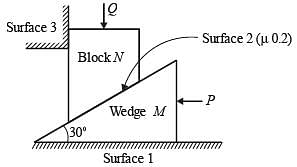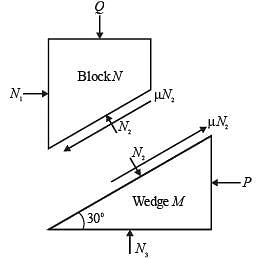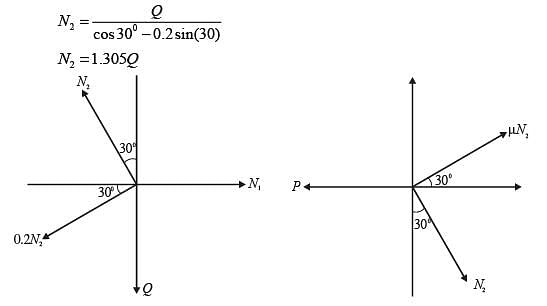Civil Engineering (CE) Exam > Civil Engineering (CE) Questions > A wedge M and a block N are subjected to forc...
Start Learning for Free
A wedge M and a block N are subjected to forces P and Q as shown in the figure. If force P is sufficiently large, then the block N can be raised. The weights of the wedge and the block are negligible compared to the forces P and Q. The coefficient of friction (μ) along the inclined surface between the wedges and the block is 0.2. All other surface are frictionless. The wedge angle is 30°.

The limiting force P, in terms of Q, required for impending motion of block N to just move it in the upward direction is given as P = αQ . The value of the coefficient ‘α’ (round off to one decimal place) is

The limiting force P, in terms of Q, required for impending motion of block N to just move it in the upward direction is given as P = αQ . The value of the coefficient ‘α’ (round off to one decimal place) is
- a)2
- b)0.5
- c)0.6
- d)0.9
Correct answer is option 'D'. Can you explain this answer?
Verified Answer
A wedge M and a block N are subjected to forces P and Q as shown in th...
Given : Friction factor of surface 2μ = 0.2

Free body diagram, N2 cos 30° = 0.2 N2 sin 30° + Q

P = 0.2 × 1.305Q cos (30) + 1.305QQ sin(30°)
P = 0.878Q
Given condition,
P = αQ
α = 0.878


Free body diagram, N2 cos 30° = 0.2 N2 sin 30° + Q

P = 0.2 × 1.305Q cos (30) + 1.305QQ sin(30°)
P = 0.878Q
Given condition,
P = αQ
α = 0.878

Most Upvoted Answer
A wedge M and a block N are subjected to forces P and Q as shown in th...
Given : Friction factor of surface 2μ = 0.2

Free body diagram, N2 cos 30° = 0.2 N2 sin 30° + Q

P = 0.2 × 1.305Q cos (30) + 1.305QQ sin(30°)
P = 0.878Q
Given condition,
P = αQ
α = 0.878


Free body diagram, N2 cos 30° = 0.2 N2 sin 30° + Q

P = 0.2 × 1.305Q cos (30) + 1.305QQ sin(30°)
P = 0.878Q
Given condition,
P = αQ
α = 0.878


|
Explore Courses for Civil Engineering (CE) exam
|

|
Similar Civil Engineering (CE) Doubts
A wedge M and a block N are subjected to forces P and Q as shown in the figure. If force P is sufficiently large, then the block N can be raised. The weights of the wedge and the block are negligible compared to the forces P and Q. The coefficient of friction (μ) along the inclined surface between the wedges and the block is 0.2. All other surface are frictionless. The wedge angle is 30°. The limiting force P, in terms of Q, required for impending motion of block N to just move it in the upward direction is given as P = αQ . The value of the coefficient ‘α’ (round off to one decimal place) isa)2b)0.5c)0.6d)0.9Correct answer is option 'D'. Can you explain this answer?
Question Description
A wedge M and a block N are subjected to forces P and Q as shown in the figure. If force P is sufficiently large, then the block N can be raised. The weights of the wedge and the block are negligible compared to the forces P and Q. The coefficient of friction (μ) along the inclined surface between the wedges and the block is 0.2. All other surface are frictionless. The wedge angle is 30°. The limiting force P, in terms of Q, required for impending motion of block N to just move it in the upward direction is given as P = αQ . The value of the coefficient ‘α’ (round off to one decimal place) isa)2b)0.5c)0.6d)0.9Correct answer is option 'D'. Can you explain this answer? for Civil Engineering (CE) 2025 is part of Civil Engineering (CE) preparation. The Question and answers have been prepared according to the Civil Engineering (CE) exam syllabus. Information about A wedge M and a block N are subjected to forces P and Q as shown in the figure. If force P is sufficiently large, then the block N can be raised. The weights of the wedge and the block are negligible compared to the forces P and Q. The coefficient of friction (μ) along the inclined surface between the wedges and the block is 0.2. All other surface are frictionless. The wedge angle is 30°. The limiting force P, in terms of Q, required for impending motion of block N to just move it in the upward direction is given as P = αQ . The value of the coefficient ‘α’ (round off to one decimal place) isa)2b)0.5c)0.6d)0.9Correct answer is option 'D'. Can you explain this answer? covers all topics & solutions for Civil Engineering (CE) 2025 Exam. Find important definitions, questions, meanings, examples, exercises and tests below for A wedge M and a block N are subjected to forces P and Q as shown in the figure. If force P is sufficiently large, then the block N can be raised. The weights of the wedge and the block are negligible compared to the forces P and Q. The coefficient of friction (μ) along the inclined surface between the wedges and the block is 0.2. All other surface are frictionless. The wedge angle is 30°. The limiting force P, in terms of Q, required for impending motion of block N to just move it in the upward direction is given as P = αQ . The value of the coefficient ‘α’ (round off to one decimal place) isa)2b)0.5c)0.6d)0.9Correct answer is option 'D'. Can you explain this answer?.
A wedge M and a block N are subjected to forces P and Q as shown in the figure. If force P is sufficiently large, then the block N can be raised. The weights of the wedge and the block are negligible compared to the forces P and Q. The coefficient of friction (μ) along the inclined surface between the wedges and the block is 0.2. All other surface are frictionless. The wedge angle is 30°. The limiting force P, in terms of Q, required for impending motion of block N to just move it in the upward direction is given as P = αQ . The value of the coefficient ‘α’ (round off to one decimal place) isa)2b)0.5c)0.6d)0.9Correct answer is option 'D'. Can you explain this answer? for Civil Engineering (CE) 2025 is part of Civil Engineering (CE) preparation. The Question and answers have been prepared according to the Civil Engineering (CE) exam syllabus. Information about A wedge M and a block N are subjected to forces P and Q as shown in the figure. If force P is sufficiently large, then the block N can be raised. The weights of the wedge and the block are negligible compared to the forces P and Q. The coefficient of friction (μ) along the inclined surface between the wedges and the block is 0.2. All other surface are frictionless. The wedge angle is 30°. The limiting force P, in terms of Q, required for impending motion of block N to just move it in the upward direction is given as P = αQ . The value of the coefficient ‘α’ (round off to one decimal place) isa)2b)0.5c)0.6d)0.9Correct answer is option 'D'. Can you explain this answer? covers all topics & solutions for Civil Engineering (CE) 2025 Exam. Find important definitions, questions, meanings, examples, exercises and tests below for A wedge M and a block N are subjected to forces P and Q as shown in the figure. If force P is sufficiently large, then the block N can be raised. The weights of the wedge and the block are negligible compared to the forces P and Q. The coefficient of friction (μ) along the inclined surface between the wedges and the block is 0.2. All other surface are frictionless. The wedge angle is 30°. The limiting force P, in terms of Q, required for impending motion of block N to just move it in the upward direction is given as P = αQ . The value of the coefficient ‘α’ (round off to one decimal place) isa)2b)0.5c)0.6d)0.9Correct answer is option 'D'. Can you explain this answer?.
Solutions for A wedge M and a block N are subjected to forces P and Q as shown in the figure. If force P is sufficiently large, then the block N can be raised. The weights of the wedge and the block are negligible compared to the forces P and Q. The coefficient of friction (μ) along the inclined surface between the wedges and the block is 0.2. All other surface are frictionless. The wedge angle is 30°. The limiting force P, in terms of Q, required for impending motion of block N to just move it in the upward direction is given as P = αQ . The value of the coefficient ‘α’ (round off to one decimal place) isa)2b)0.5c)0.6d)0.9Correct answer is option 'D'. Can you explain this answer? in English & in Hindi are available as part of our courses for Civil Engineering (CE).
Download more important topics, notes, lectures and mock test series for Civil Engineering (CE) Exam by signing up for free.
Here you can find the meaning of A wedge M and a block N are subjected to forces P and Q as shown in the figure. If force P is sufficiently large, then the block N can be raised. The weights of the wedge and the block are negligible compared to the forces P and Q. The coefficient of friction (μ) along the inclined surface between the wedges and the block is 0.2. All other surface are frictionless. The wedge angle is 30°. The limiting force P, in terms of Q, required for impending motion of block N to just move it in the upward direction is given as P = αQ . The value of the coefficient ‘α’ (round off to one decimal place) isa)2b)0.5c)0.6d)0.9Correct answer is option 'D'. Can you explain this answer? defined & explained in the simplest way possible. Besides giving the explanation of
A wedge M and a block N are subjected to forces P and Q as shown in the figure. If force P is sufficiently large, then the block N can be raised. The weights of the wedge and the block are negligible compared to the forces P and Q. The coefficient of friction (μ) along the inclined surface between the wedges and the block is 0.2. All other surface are frictionless. The wedge angle is 30°. The limiting force P, in terms of Q, required for impending motion of block N to just move it in the upward direction is given as P = αQ . The value of the coefficient ‘α’ (round off to one decimal place) isa)2b)0.5c)0.6d)0.9Correct answer is option 'D'. Can you explain this answer?, a detailed solution for A wedge M and a block N are subjected to forces P and Q as shown in the figure. If force P is sufficiently large, then the block N can be raised. The weights of the wedge and the block are negligible compared to the forces P and Q. The coefficient of friction (μ) along the inclined surface between the wedges and the block is 0.2. All other surface are frictionless. The wedge angle is 30°. The limiting force P, in terms of Q, required for impending motion of block N to just move it in the upward direction is given as P = αQ . The value of the coefficient ‘α’ (round off to one decimal place) isa)2b)0.5c)0.6d)0.9Correct answer is option 'D'. Can you explain this answer? has been provided alongside types of A wedge M and a block N are subjected to forces P and Q as shown in the figure. If force P is sufficiently large, then the block N can be raised. The weights of the wedge and the block are negligible compared to the forces P and Q. The coefficient of friction (μ) along the inclined surface between the wedges and the block is 0.2. All other surface are frictionless. The wedge angle is 30°. The limiting force P, in terms of Q, required for impending motion of block N to just move it in the upward direction is given as P = αQ . The value of the coefficient ‘α’ (round off to one decimal place) isa)2b)0.5c)0.6d)0.9Correct answer is option 'D'. Can you explain this answer? theory, EduRev gives you an
ample number of questions to practice A wedge M and a block N are subjected to forces P and Q as shown in the figure. If force P is sufficiently large, then the block N can be raised. The weights of the wedge and the block are negligible compared to the forces P and Q. The coefficient of friction (μ) along the inclined surface between the wedges and the block is 0.2. All other surface are frictionless. The wedge angle is 30°. The limiting force P, in terms of Q, required for impending motion of block N to just move it in the upward direction is given as P = αQ . The value of the coefficient ‘α’ (round off to one decimal place) isa)2b)0.5c)0.6d)0.9Correct answer is option 'D'. Can you explain this answer? tests, examples and also practice Civil Engineering (CE) tests.

|
Explore Courses for Civil Engineering (CE) exam
|

|
Signup for Free!
Signup to see your scores go up within 7 days! Learn & Practice with 1000+ FREE Notes, Videos & Tests.


























